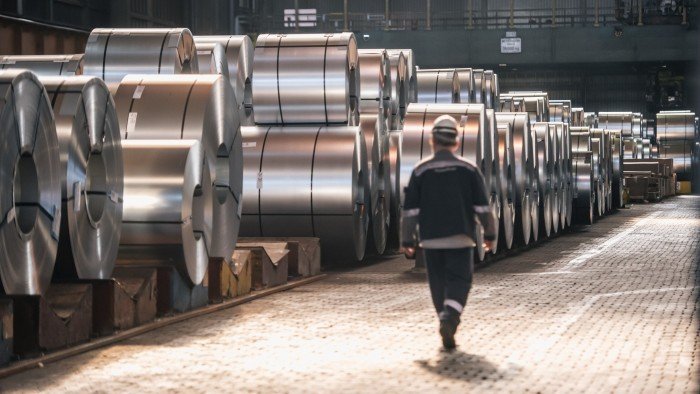Stay updated with our free alerts
Sign up for the EU trade myFT Digest and receive it directly in your inbox.
Europe is experiencing a significant influx of steel redirected from the US due to high tariffs, with certain product imports increasing by ten times since the start of the year, according to a new monitoring system.
The steel industry in Europe is urging Brussels to implement urgent measures as this influx is likely to drive prices down within the EU.
“Now is the time to take action,” said Ilse Henne, chair of the supervisory board at Thyssenkrupp, in a statement to the FT.
This alert followed the European Commission’s initial surveillance report intended to identify increases in imports after Donald Trump resumed his presidency, hinting at new tariffs. It revealed major escalations in import volumes and steep price declines across various products, including guitars and industrial robots, since January 1.
Imports of stainless steel bars and rods surged by over 1,000% year-on-year, with prices plummeting by 88%. Other types of steel bars and rods saw a 222% increase, while their prices fell by 55%.

“With this new import surveillance tool, we are enhancing our ability to safeguard our interests and curb import surges targeting our market,” stated Maroš Šefčovič, the EU trade commissioner.
Electric guitar imports rose by nearly 500%, with prices dropping to a fifth of their previous levels, and industrial robots saw a 315% increase in imports, with prices decreasing by a third.
Significant increases were also noted in plywood, aluminum foil, and alcoholic beverages.
The report’s heat map indicated that China has been a major source of increased imports in machinery, textiles, chemicals, and wood and paper products.
Additionally, there was a notable rise in imports of food, beverages, and chemicals from the US, as businesses prepared for potential EU retaliatory tariffs.
Analysts have advised caution, stating that the automated customs data may not be entirely accurate because it amalgamates products with vastly different price ranges, suggesting consumers could also be making less expensive choices.
However, Henne emphasized that the threats to the steel sector are genuine. The EU has had safeguard measures in effect since 2016, imposing 25% tariffs on imports exceeding a certain quota, although these are set to be relaxed before their expiration in 2026.
Šefčovič assured that he would propose a new replacement system by this summer.
Henne urged for a rapid implementation of a strategy to support the industry by lowering energy costs and focusing on domestic production for public contracts.
“Companies outside the EU must adhere to the same climate, market openness, and competition standards — failing which could compromise our resilience,” she noted.

She also advocated for tariffs on imported steel from Russia. Although finished and semi-finished products were banned following the 2022 invasion of Ukraine, steel slabs remained exempt.
Henne stated that Thyssenkrupp is scaling back its production capacity from 11 million to 9 million tonnes per year due to weak demand, resulting in significant job losses.
This week, the US imposed 50% tariffs on steel and aluminum, escalating the 25% tariffs introduced by the president last March.
Eurofer, representing the industry, stated that EU steel consumption is expected to decline by 0.9% in 2025, marking the fourth consecutive year of recession. Nonetheless, imports continue to rise.
“Given the persistent decline in the outlook for the EU steel market, we urge the European Commission to explore emergency trade measures to stabilize the steel market within the EU,” remarked Axel Eggert, Eurofer’s director-general.

